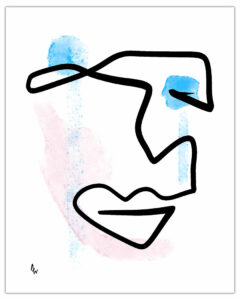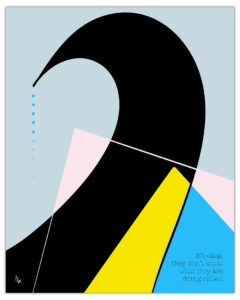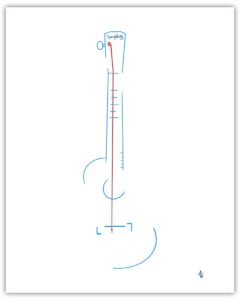From the time we’re kids, we’re taught that the rules of society serve harsh punishments for stealing, for plagiarizing, for being unoriginal. All while we’re being socially conditioned to conform and ultimately be … unoriginal.
Should it be any wonder artists often are seen as non-conformists, as rebels, as different and even difficult for the masses to understand … and yet simultaneously be romanticized as living their dreams, vague and foreign as they might seem to those masses?
The individual journey to shed that conditioning and discover (or recover) our unique light and creative gifts is arduous. It can be a desert of confusion, in which we’re constantly questioning ourselves and seeking nourishment to just keep going.
“Who am I? Who am I, really?”
 In the lifelong effort (and then some?) to answer that question, I think we go through a period of rejecting who anyone else has been, because, after all, how can we be original if we choose from the existing inventory of possibilities?
In the lifelong effort (and then some?) to answer that question, I think we go through a period of rejecting who anyone else has been, because, after all, how can we be original if we choose from the existing inventory of possibilities?
Nonetheless, in searching for who we are we often reference others. All the more consciously so when we’re in the early stages of Self-recovery (big-S Self, the truest, bestest version of our beings). We might echo their work, their design sense, their language, their sources.
Maybe we start out by imitating them closely and experimenting with who we think they are, to try on that other’s walk. And then we build upon something we’ve found there as a means of coming to something that feels more like us.
As Twyla Tharp has said, it’s “digging through everything to find something … grabbing that piece of fire and running like hell.”
On one level, I don’t worry a lot about if or how my creative work might resemble another’s. I learned nearly 20 years ago in journalism school that no idea is original.
On another level, I know I want to be the meest me I can be. I want to be appreciated for being me, not for being like someone else. I want to be authentic and to make authentic connections, with my work and with others. Not to be dismissed as an imitator, unoriginal.
But I’ve re-learned again and again over the years since graduate school that we all are amalgamations of everyone we’ve known, every book we’ve read, every song … every everything. We all are that unique blend of our influences and inspirations — and the way we make use of them.
 Ralph Waldo Emerson said, “Old and new make up the warp and woof of every moment … We all quote. In fact, it is as difficult to appropriate the thoughts of others as it is to invent.”
Ralph Waldo Emerson said, “Old and new make up the warp and woof of every moment … We all quote. In fact, it is as difficult to appropriate the thoughts of others as it is to invent.”
Or simpler yet, Mark Twain: “All ideas are second-hand.”
The “writer who draws,” Austin Kleon, published a book on this subject, “Steal Like An Artist.” He also published a blog post about influences more than 10 years ago that still holds, and forever will. Evergreen is the flow of influence in our creativity.
When I posted two colorful, geometric artworks a couple months ago on Instagram and in my online art shop [“Eye On Your Dreams” and “Maya (Illusions)” … Update, Dec. 2022: The shop is inactive], my wife, Becca, saw them and she was reminded of the artist Joan Miró.
Likewise, I got a message from an artist-friend, Ramón Aguirre, who saw the same works and was reminded of Wassily Kandinsky.
Now, I’ve not studied Miró or Kandinsky. I’ve never had so much as a general art history class. My learning has come by accumulation of dribs here and there, by curiosity and chance.
I have what feels like vague awareness of Miró or Kandinsky. And as soon as Becca and Ramón brought it up, I also could see the visual thread that runs from some of my work to theirs.
It’s funny to me, fascinating even, how we absorb our culture and history without even realizing it. All matters of culture.
Another example: 15 years ago I was eating in a Hardees in South Dakota, and at a table next to mine was the legendary race car driver Richard Petty.

How did I know that’s who it was? I’m not a racing fan; I have never read so much as a magazine article about Richard Petty. I can’t tell you one thing about his career or life.
But the guy has a visual brand, a trademark look — black cowboy hat and black sunglasses — that even I, a non-racing fan, had unwittingly taken into my subconscious somewhere over the years.
Creative work has the power to stick with us, to alter our experience. To inspire. To influence. Those influences serve as guides, stars at sea, and even as sources of permission for our questioning, unsure selves.
They also deserve credit.
Recent Creative Influences
I mentioned Miró and Kandinsky. Others from days gone by: Pablo Picasso, Piet Mondrian, Mark Rothko. And John Lennon.
John Lennon probably was the first artist whose simple line drawings got my attention. I hadn’t known he made visual art. “Just” music. I hadn’t known simple was acceptable, that art — so-called real art — could be made from a breath’s-length of pen strokes. That was more than 20 years ago.
I had gone to a traveling show of Lennon’s work at a hotel in Monterey, Calif. I was living there at the time. I was in the Army. I was in my early 20s. I was engaging with all kinds of things for the first time — San Francisco, skydiving, scuba diving, studying Korean. The world was new and opening to me; I was seeking it.
I had little money, little autonomy for the foreseeable years I was enlisted, and little wall space for hanging art, which, come to think of it, I’m not sure even would have been allowed.
In short, there was no way I could buy a piece of Lennon’s work. I could, however, buy the catalog from the show, which held many sketches and drawings he’d done. Seeing Lennon in this light opened my mind, even granted me some sense of permission to cross between talents/mediums and to make simple, uncomplicated work.

Now, I’ve been creating in various mediums for many years. It’s a pursuit of simplicity, of distilling complexity. It’s not necessarily because of seeing Lennon’s line drawings that I’m an artist now, but clearly something was percolating. I saw something and held onto it until it became useful.
And along with those influences from the past are many contemporary artists around the globe who have caught my attention through the ethers of the Internet. They have entered the subconscious of my creative practices.
Some of these influences are: Eitil Thorén Due (@peytil), Swedish; Shira Barzilay (@koketit), Israeli; Christophe Louis (@quibe), French; Niels Kiené (@salventius) Dutch; Marin Vaan Zaal (@vaanzaal), American.
I stumble onto more all the time.
Only yesterday I found these artists who likewise are exploring with simplicity, lines, colors and geometrics in ways that resonate with me: Mafalda Vasconcelos (@mmvce), Mozambican; Carmel Jenkin (@carmeljenkin), Australian; María Dalli (@m.dalli_lineart), Spanish; Polly Mann (@mann.wear), English; Augusto B.M. (@_augustobm), Brazilian.
If you are aware of other artists you think I’d like to know about, feel free to share. Send me a direct message via Instagram (@humanitou) or an email.
Mediums & Technology
With all the work of these influences flowing, I’ve been re-entering and exploring areas I’ve dipped into over the years — simplicity, humanity, nature — but hadn’t built daily creative practices around until recently.
Part of the answer for me has been trying out digital tools. It’s a format new to me for creating (non-photographic) visual art. Using the Procreate app on iPad, I create daily in a different way than I do in traditional/analog mediums.
It allows me to create more prolifically with less waste of materials, less expense, and with far less frustration with myself. That allows me to fail fast and learn, stretching my ideas and skills further, faster.
 I create as many as 25 or more pieces a day. With that kind of experimentation and speed, I don’t have a lot of time to dwell on my “failings,” to beat myself up. At least not as much as I otherwise have been known — by my wife, mostly — to do.
I create as many as 25 or more pieces a day. With that kind of experimentation and speed, I don’t have a lot of time to dwell on my “failings,” to beat myself up. At least not as much as I otherwise have been known — by my wife, mostly — to do.
The thread of the work is the same as when I draw on paper — simplicity, abstraction, line drawing, geometrics, subtlety, color (and lack of it). It’s only the tools that have changed.
Working digitally allows me to create final pieces and/or to experiment with what might end up serving as studies for taking ideas to hardcopy materials in the future (e.g. paints and charcoals, papers and canvases).
Soon enough, I will take one or more of these ideas and paint a mural on at least one wall of my new home studio, joining mediums, technology and the power of creative influence.
I’ve never painted a mural before. But I’ve been influenced to make the leap, in part, by artists I’ve talked with for Humanitou. Muralists Gregg Deal, “Jetsonorama” (Chip Thomas) and Molly McClure come to mind. So do Virgil Ortiz, Brother Luck and Lisa Congdon.
Each of the artists I’ve named throughout this blog post is part of the amalgamation of me, the inspiration to me to do more, to push further, to be willing to fail at something new.
All in the pursuit of learning how to be just a bit less unoriginal in my own way.


